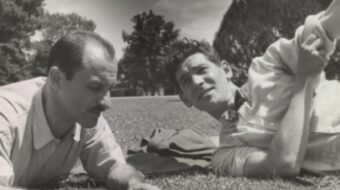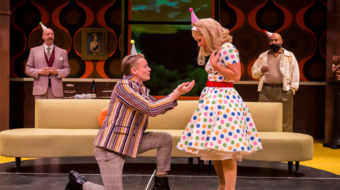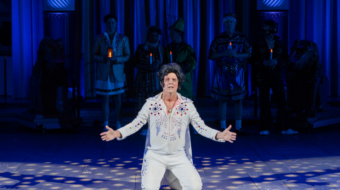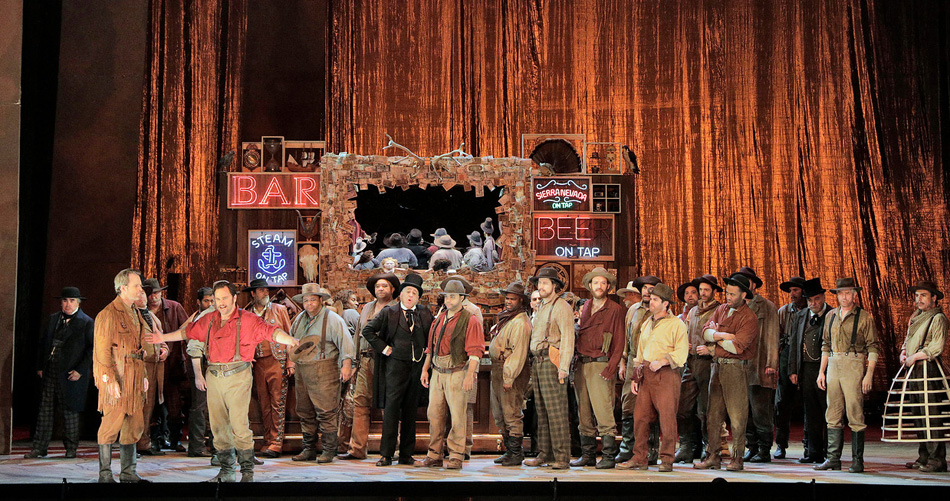
SAN FRANCISCO—The world premiere of John Adams and Peter Sellars’ new opera Girls of the Golden West (seen Nov. 21) took place two days before Thanksgiving. The first Thanksgiving took place in 1621, and what we call the “Indian Wars” began in 1622. It didn’t take long before the intercultural New World kumbaya collapsed into European racial supremacism.
A similar pattern emerged in the West. In the resolution of the Mexican-American War of 1846-48, the U.S. acquired about half of Mexico’s territory, including California. According to the opera program, “In March 1848, there were fewer than 800 non-native Americans in California. After the Gold Rush…the population soared to 300,000 new Americans, many of them settling in boomtowns such as Downieville. Yet there were very few women among them. By 1860, adult women made up just 19 percent of the state’s population.”
Girls of the Golden West is set in this early, male-centric 1850s Gold Rush era, directing our attention to several women who made their mark on the new state. The title recalls the 1910 “spaghetti Western” opera La Fanciulla del West by Giacomo Puccini, based on the American play The Girl of the Golden West by David Belasco, whose father was one of the original 49ers.
The New York Times singled out this San Francisco Opera (SFO) premiere as “the most eagerly anticipated new opera of the season.”
A comparable story about the intersectionality among white, Latino and native populations in California, though far less bloody in the telling, is the classic epic Ramona.
Adams began composing Girls two and a half years ago, at a time when the popular President Barack Obama could optimistically look forward to handing over the White House to his Democratic Party successor. Much water has flowed out of California’s Sierra Nevada since. At the premiere, before the first note of the opera was heard, the supertitle panel displayed the names of the opera sponsors. Applause broke out when “National Endowment for the Arts” was projected. This is a new American opera with a fresh, radically critical look at our history that either our current president or vice president would likely walk out on.
Immediately following the opera’s performance, John Adams was presented with the San Francisco Opera Medal, the first time to a composer, by Company General Director Matthew Shilvock. Adams recalled: “When word came out about what this opera was about, people said, ‘Well, that’s not a John Adams opera. He’s written about presidential politics, terrorism and the invention of the atomic bomb.’ But Girls of the Golden West is very much about right now. What gives me hope is that I live in California.”
Adams, originally from Massachusetts but a resident of Berkeley for many years and owner of a cabin in the Sierra Nevada mountains, turned 70 in February. He was internationally celebrated by a whirlwind of concerts. His works, both operatic and symphonic, stand out among the world’s best-crafted contemporary classical compositions. His stage works, all in collaboration with Peter Sellars, include Nixon in China (1987), The Death of Klinghoffer (1991), El Niño (2000), Doctor Atomic (2005), A Flowering Tree (2006), the Passion oratorio The Gospel According to the Other Mary (2012), and now Girls of the Golden West. Four of his operas have been presented by SFO.
Girls is based on period sources thoroughly researched by Peter Sellars: miners’ diaries, newspaper stories, speeches, poems in both English and Spanish, Mark Twain (his memoir Roughing It), and 15 song lyrics from the era, some collected in the 1854 Put’s Original California Songster, and others from Songs of the Great American West, compiled and edited by the Marxist writer Irwin Silber with music edited and arranged by Earl Robinson.
The principal muse of the project, however, is Louise Amelia Clappe (1819-1906), who recreated herself as “Dame Shirley.” She and her physician husband Fayette, both Easterners, arrived in the settlement of Rich Bar, 200 miles northeast of San Francisco on the Feather River. From there she wrote dozens of long, detailed, articulate and observant letters back home to her sister in Amherst, Mass., later published in book form. Primitive though it was, without any of her customary civilized comforts, “This strange life fascinates me.” She serves as the narrator of much of the action in the opera, magnificently interpreted by Julia Bullock.
Other characters in this frontier, Rise and Fall of the City of Mahagonny-like work include Ned Peters, an escaped slave (Davóne Tines); Joe Cannon (Paul Appleby), a white miner with a volatile temper; Clarence (Ryan McKinny), a white miner down on his luck; Ramón (Elliot Madore), a Chilean who has made his way up to gold country. And two other women from the title: Ah Sing (Hye Jung Lee), a Chinese prostitute whose goals are to save money, marry well and own a farm—her texts derive from Songs of Gold Mountain: Cantonese Rhymes from San Francisco Chinatown and Kenneth Rexroth’s adaptation of Chinese poetry; and Josefa Segovia (J’Nai Bridges), of native Mexican origin. Most of these are based on historical figures, as is the dancing role of Lola Montez, performed by ballerina Lorena Feijóo. All the soloists are young singers in their 20s and 30s who perform this challenging music superlatively. Maestro Grant Gershon, an experienced Adams hand, conducts this complex score with magisterial authority.
Dame Shirley has an almost mystical encounter with some native women, but there is no indigenous character as such. The premise of the opera recognizes the genocide against First Nation people (90 percent were exterminated by 1857), but at the time even the most humane whites saw extinction as largely regrettable but inevitable.
In a rowdy barroom dancing scene one man appears with a ladies’ hoop dress form around his waist, which he swirls in time with the music—a subtle hint at the presence of gay men in that über-macho environment?
At the pre-opera talk with the librettist, Sellars asserted that “California is a great topic and the whole world knows that…. Gold in California was world news,” and led to possibly “the world’s first multicultural society.” He was asked how much relation Girls has to Puccini. “None at all,” he replied. But perhaps he protests too quickly.
La Fanciulla del West is considered Puccini’s musically most advanced score, with strong influences of Debussy in its smoky, chromatic orchestration. It also features a mostly male chorus and to an extent romanticizes the era and characters. In Girls the sentimentalism goes only one way, however: With the exception of narrator Dame Shirley and her husband Fayette (Kai Brothers in a subservient role), all the other white and male characters are part of the miners’ mob given to racist, drunken vigilantism and hyper-American patriotism. Whereas the other two “girls,” the formerly enslaved Ned, the Latinas and Latinos and the indigenous people, all possess a poetic nobility of deed and sentiment that stands out all too politically and obviously correctly.
Now of course positive images of the multiracial composition of the mining camps should be brought out (which Puccini did not effectively do); but from a believable dramatic point of view, it just does not make sense, for example, for the lovers (perhaps newlyweds) Ramón and Josefa to be exchanging romantic verses of the much later Argentine poet Alfonsina Storni (1892-1938) from a book published in 1919.
Ned’s two big arias are drawn from The Life and Adventures of James Williams, a Fugitive Slave, and from Frederick Douglass’ oft-quoted July 5, 1852, oration What to a Slave is the Fourth of July? Ned attempts to live in such a way, as Antony says of Julius Caesar, that people will say of him, “This was a man” (of course recalling the famous slogan of the Memphis sanitation workers of 1968). The Douglass aria delivered straight to the audience includes that passage about Black Americans engaging in every sort of profession and trade, and even worshiping the Christian’s God, yet “Still we are called upon to prove that we are men!” Other references to Shakespeare abound in the opera, especially the murderous Macbeth, whose story of betrayal and usurpation mirrors the lawless Gold Rush mentality. We are reminded that Shakespeare was well-known and deeply loved in 19th-century America.
As a character, Ned’s storyline is mashed into Dame Shirley’s. They are portrayed quite publicly doting on each other, even in the presence of her husband, and in one scene he prepares an elaborate “coronation dinner” for his “queen.” It would seem they are having an affair. It’s not my business, of course, but how would they have gotten away with it at the time? The relationship seems forced out of the documentary sources and twisted into something quite unrecognizable.
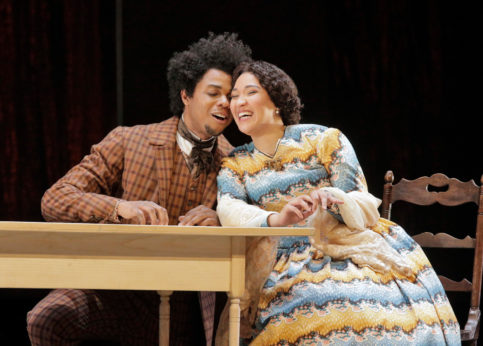
Another conflation of probably unrelated stories takes place between two real persons: Ramón Gil Navarro, who wrote a book about his Gold Rush experience, and (in the opera) his lover Josefa Segovia, who in self-defense stabbed Joe Cannon to death on July 4, 1851. She was hanged by the mob the next day.
The program admits to some creative license in dates when certain historical events took place, but does not address these illogical plot points. A further confusing character is Joe Cannon, whose identity morphs several times: Frequenter of prostitutes, he gradually falls in love with Ah Sing, becomes in fact her secret husband, then turns into a failed miner needing to escape (from an anti-Chinese mob or from his debts?), and finally turns up on Josefa’s doorstep. The Empire Bar, in one of the many hotels that housed and entertained the miners, has bright neon lights, which I could accept with an anachronistic smile. The opera employs a generously sized rolling panorama as an authentic 19th-century theatrical effect.
These are a few of the narrative continuity issues which could be addressed before Girls departs for its next venue. Excessive fidelity to the sources can be problematic if it draws away from developing solid characters. Perhaps some of the extended poetry might be cut back as unnecessary: Presently the work runs three hours, 21 minutes with one intermission—overly long, I would say, by 21 minutes.
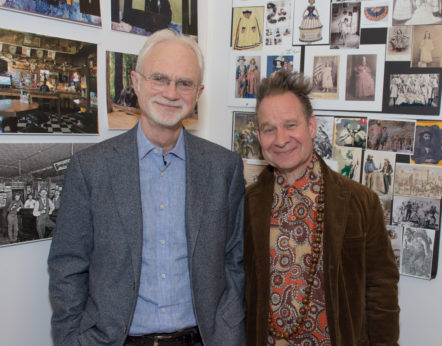
As part of Peter Sellars’ concept, the audience can see past the sets and watch the backstage activity. This conceit actually fulfills a unique purpose from time to time: For example, in a scene where the mob is being riled up against the Latinos, they are first heard singing off-stage, and we see the assistant conductor leading that chorus, suggesting that behind the scenes there are other forces “orchestrating” the nativism. The mob carries Tiki torches—hmmm, where have we seen those lately?
As a musical-theatrical treatment of gender, race and ethnicity, immigration, vigilante justice, and the foundational myths of a country always asking, “Who is a real American?” Adams and Sellars have succeeded, as Sellars says, in “evoking a certain period of American history, but this opera also carries the DNA of our period right now.” Much is made of the first Fourth of July in the newly American California (Adams uses descending fourths as his musical motif for this scene).
The creative team makes good use of alarming contrast, showing up the hypocrisy of American idealism and practice. The mob gathers while the chorus sings, “To one and all both young and old, / You’re welcome to the land of gold.” Dame Shirley comments on the massacre, “I hadn’t realized that in the 19th century men could be beaten like dogs.”
Another issue suggested by the opera is the boom and bust cyclical nature of the American economy. San Francisco, which so many Silicon Valley workers call home, is a good place to ruminate on that.
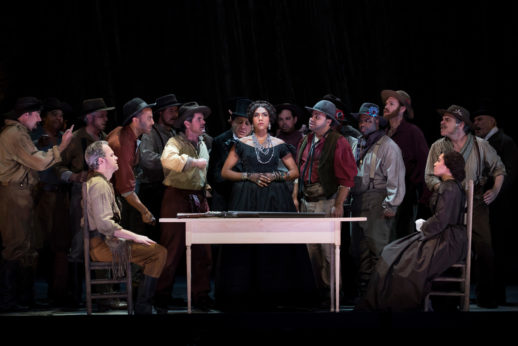
As historian Gary Kamiya writes, “Like all of us, they were shaped by the attitudes, beliefs, and prejudices of their time, and the anarchic, greed-driven universe of the mining camps allowed those prejudices to blossom. The diggings were a great crucible, a test of character. Some Argonauts failed the test; others proved to be made of the highest mettle; most fell in between.”
Above all, Girls is a deeply human piece, a pageant about ambitious people who sought to recreate themselves. The final words of the opera belong to Dame Shirley, contemplating the skies and landscape of California and pronouncing it, as so many generations since have done, “fathomless splendor.”
Girls is a co-commission by the Dutch National Opera, Amsterdam (look for it in early 2019) and the Dallas Opera (March 2021).
Remaining performances of Girls of the Golden West take place on Nov. 29, Dec. 2, 5 and 7 at 7:30 pm, and Dec. 10 at 2 pm at the War Memorial Opera House, 301 Van Ness Ave., San Francisco. Tickets are available at the SFO website, or call (415) 864-3330. The website will also lead you to a variety of ancillary events surrounding the premiere. In the opera house lobby several display cases show fascinating original documents and artifacts of the period.



